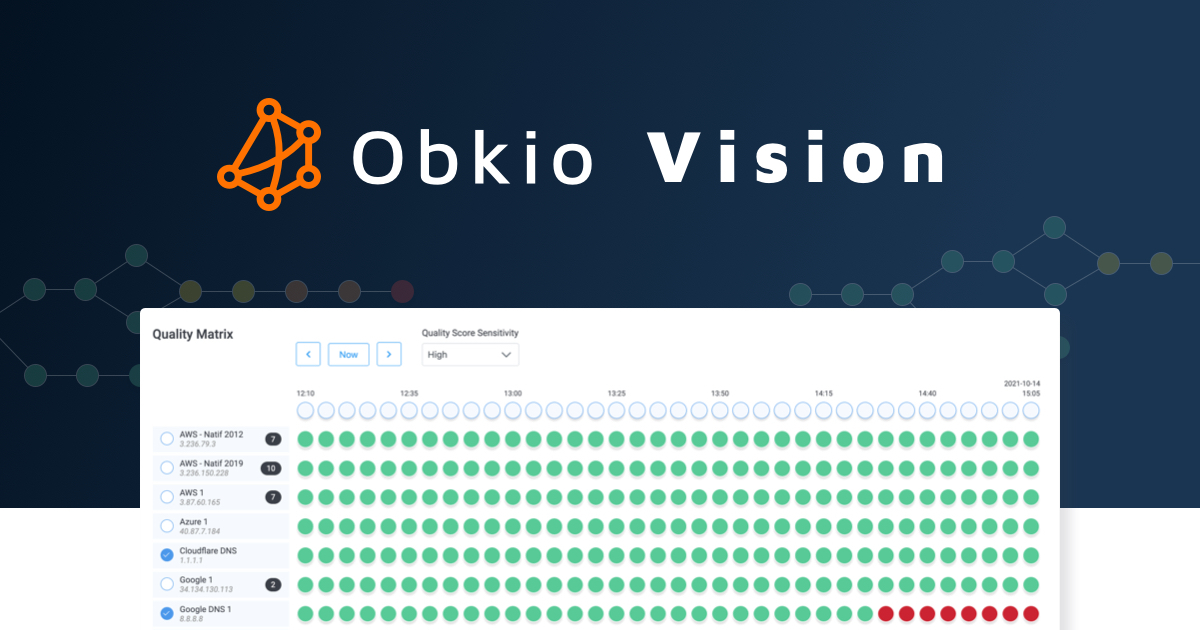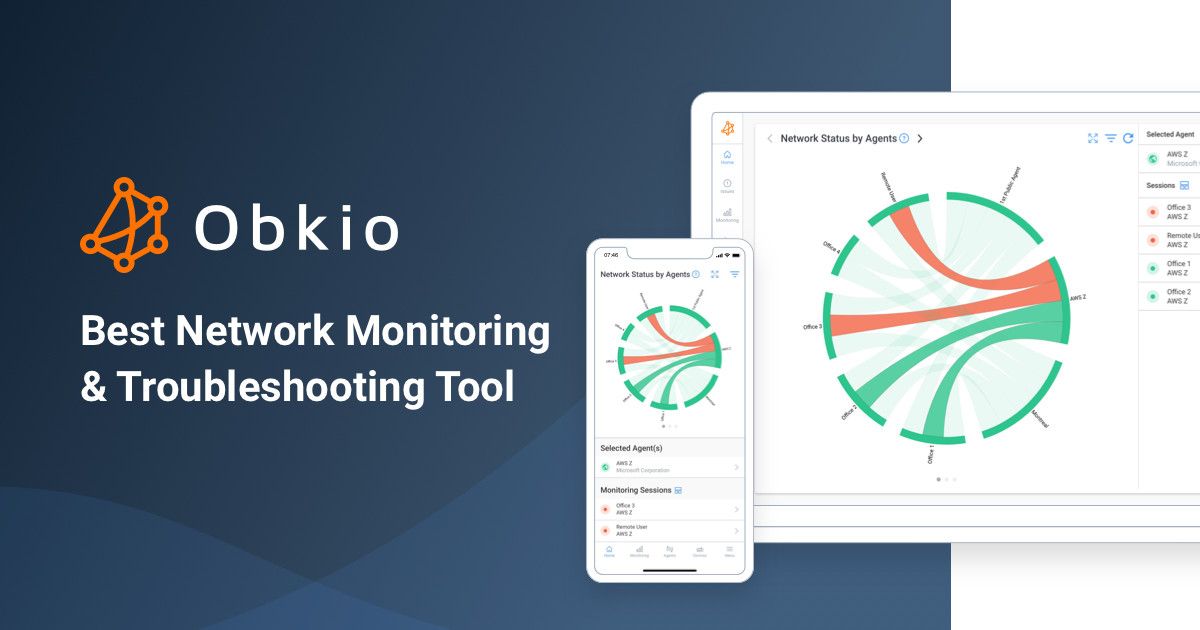Table of Contents
Table of Contents
In an age where the Internet connects people, businesses, and information across the globe, the flow of data has become the lifeblood of our digital existence. However, what many users and even some tech enthusiasts might not realize is that this data's journey is far from straightforward. The symphony of interconnected networks that make up the internet is a complex web of data routes, and these routes are not always symmetrical. This inherent asymmetry in internet traffic can lead to a host of issues, affecting everything from network performance to security.
In this blog post, we will delve into the fascinating world of internet traffic, exploring its asymmetrical nature and how this can give rise to reverse path issues. We'll also learn about a valuable diagnostic tool, the trusty "Traceroute," and how it can be harnessed to identify and resolve these problems, ensuring a smoother and more reliable internet experience for all. So, let's embark on this journey to uncover the secrets of the internet's reverse paths and discover how to catch and correct issues using Traceroutes.
Internet traffic is often described as "asymmetrical" because the flow of data between two communicating parties is not always balanced or equal in both directions. In other words, more data may be traveling in one direction than the other during a given online interaction.
There are several reasons for this asymmetrical routing:
Content Consumption vs. Content Creation: A common example of Internet traffic asymmetry is the difference between content consumption and content creation. Most Internet users spend a significant portion of their online time consuming content—such as watching videos, browsing websites, or streaming music. This type of activity primarily involves downloading data from remote servers, resulting in heavier downstream traffic (data traveling from the server to the user).
Uploading vs. Downloading: On the other hand, content creation, including activities like uploading files, sending emails, or live streaming, generates upstream traffic (data traveling from the user to a remote server). This traffic is typically much smaller in volume compared to downstream traffic.
Cloud Services: The use of cloud-based services and applications, like online document editing or file storage, contributes to traffic asymmetry. When you edit a document stored in the cloud, for instance, you're sending small changes to the server, while the server sends the entire document back to you, leading to more significant downstream traffic.
Peer-to-Peer (P2P) Sharing: P2P file sharing, often associated with torrenting, can also result in asymmetric traffic. Users downloading files through P2P networks receive data from multiple sources (peers), which can create a lot of downstream traffic. However, when they upload or seed the files, the upstream traffic is distributed across fewer connections.
Internet Services and Protocols: Various Internet services and protocols, like streaming video or online gaming, have their own traffic patterns. These services often prioritize downstream traffic to provide a smoother user experience.
Network Infrastructure: The infrastructure of the Internet itself can introduce asymmetry. Internet service providers (ISPs), for example, may design their networks to optimize downstream traffic, as this aligns with typical user behavior. This design can lead to disparities in bandwidth capacity between upstream and downstream traffic.
In summary, Internet traffic is asymmetrical because the data flows are not evenly distributed in both directions during online interactions. Downstream traffic is usually more substantial due to content consumption, while upstream traffic is comparatively smaller, primarily related to content creation and user interactions. Understanding this asymmetry is crucial for network management, capacity planning, and optimizing internet performance.
When looking at a traceroute, people often forget that traffic on the Internet is asymmetrical most of the time. It is called the Hot Potato Routing. As soon as an ISP has a packet with a destination address outside its own network, it will try to pass the packet to the next ISP ASAP.
"Hot Potato Routing" refers to a routing strategy employed by iIternet service providers (ISPs) and network operators to efficiently handle and forward internet traffic. The strategy aims to quickly offload, or pass on, data traffic to its destination, similar to handling a hot potato to avoid being burnt. In hot potato routing, the objective is to minimize the time the data spends within a network, ultimately reducing latency and enhancing network performance.
Here's how hot potato routing works:
Minimizing Latency: Hot potato routing prioritizes minimizing latency, which is the time it takes for data to travel from the source to the destination. When an ISP receives incoming traffic destined for a specific location, the goal is to get that data out of its network as quickly as possible and onto the network of the next-hop provider that can carry it closer to the destination.
Routing to Nearest Exit Point: Instead of trying to find the shortest path to the final destination, hot potato routing focuses on routing the data to the nearest exit point, or the point at which the traffic can be handed off to another network that can carry it closer to the destination. This approach helps reduce the time data spends traversing the ISP's network.
Efficient Use of Peering Points: ISPs often have agreements and peering points with other network providers to exchange traffic efficiently. Hot potato routing leverages these peering points to ensure that traffic is handed off as soon as possible to a network that is closer to the destination, even if it's not the shortest path in terms of hops.
Minimizing Internal Network Usage: By quickly offloading data traffic to other networks, hot potato routing helps avoid congestion and overutilization of an ISP's internal network, which can lead to delays and packet loss.
Dynamic Routing: To implement hot potato routing effectively, ISPs often use dynamic routing protocols that consider real-time network conditions and the available exit points. This allows for agile decision-making in choosing the exit point that minimizes latency.
Hot potato routing is particularly crucial for high-performance networks, content delivery networks (CDNs), and ISPs that prioritize low-latency and efficient data delivery. By rapidly passing data to the most appropriate egress point, hot potato routing contributes to a smoother and faster internet experience for users and ensures that data takes the shortest and fastest path to its destination.
Figure A below is a good example of the Hot Potato Routing. In the figure, there are 2 ISPs (A and B) and they both have 3 routers located in New York City (NYC), Dallas (DAL) and San Francisco (SFO). In the 3 cities, the ISPs have interconnections to exchange traffic from one network to another.
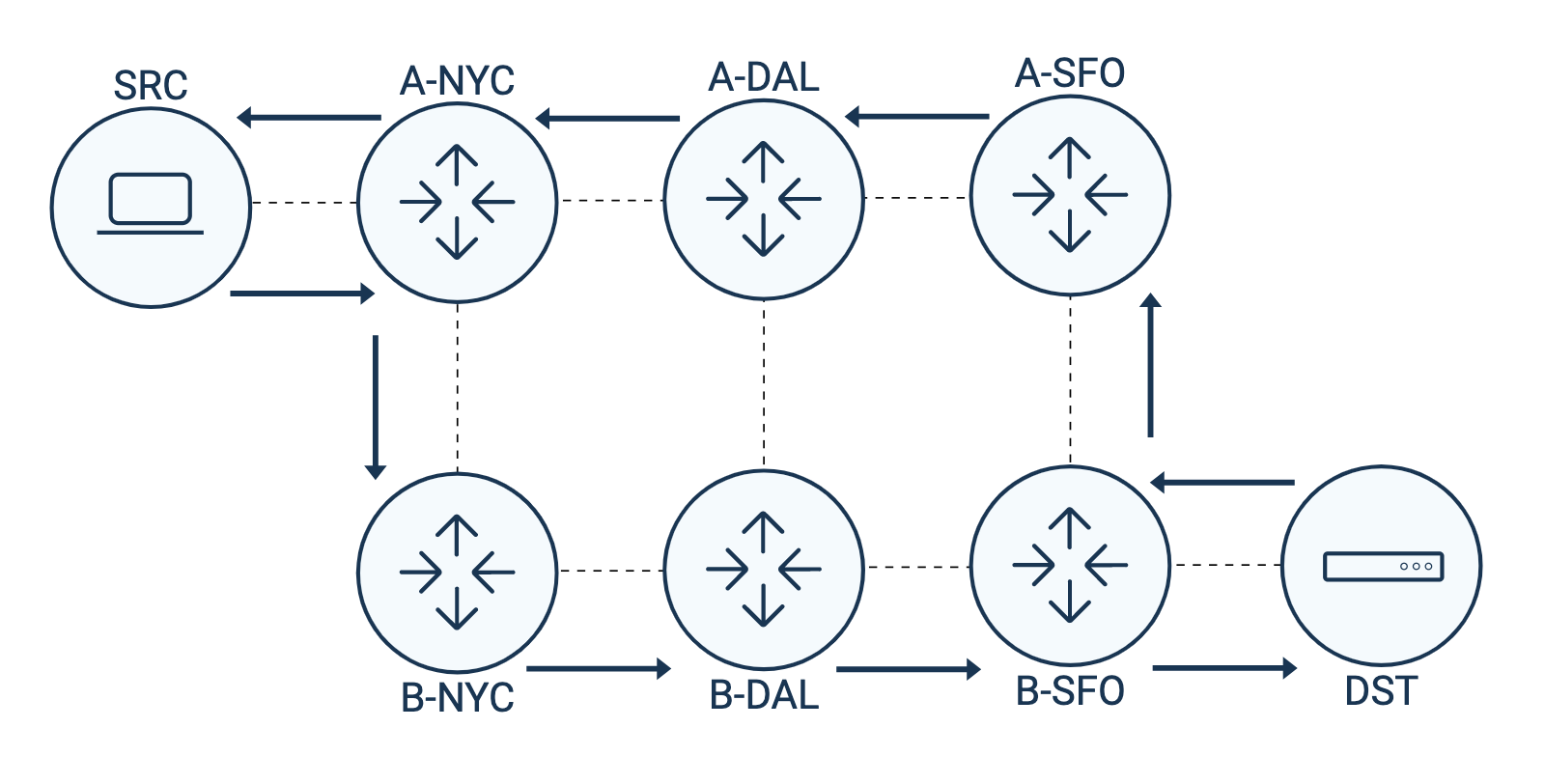
When the source SRC sends a packet to the destination DST, ISP A receives the packet on router A-NYC. As soon as it receives the packet, it will search for a way to send it to ISP B. In this case, the interconnection between the two routers in NYC is the fastest path to reach ISP B. The packet then continues its way inside ISP B up to the destination DST. The traceroute from SRC to DST will look like this:
+---+----------+-------+-----+------+------+------+------+
| # | Hostname | Loss% | Snt | Last | Avg | Best | Wrst |
+---+----------+-------+-----+------+------+------+------+
| 1 | A-NYC | 0.0 | 1 | 1.0 | 1.0 | 1.0 | 1.0 |
| 2 | B-NYC | 0.0 | 1 | 2.0 | 2.0 | 2.0 | 2.0 |
| 3 | B-DAL | 0.0 | 1 | 40.0 | 40.0 | 40.0 | 40.0 |
| 4 | B-SFO | 0.0 | 1 | 80.0 | 80.0 | 80.0 | 80.0 |
| 5 | DST | 0.0 | 1 | 81.0 | 81.0 | 81.0 | 81.0 |
+---+----------+-------+-----+------+------+------+------+
Figure B - SRC to DST
On the other side, when DST replies back to SRC, the packet goes from ISP B to A in SFO because this is the fastest route between the two networks. The forward traffic from SRC to DST uses a different path than the reverse traffic from DST to SRC. The traceroute from DST to SRC will look like this:
+---+----------+-------+-----+------+------+------+------+
| # | Hostname | Loss% | Snt | Last | Avg | Best | Wrst |
+---+----------+-------+-----+------+------+------+------+
| 1 | B-SFP | 0.0 | 1 | 1.0 | 1.0 | 1.0 | 1.0 |
| 2 | A-SFO | 0.0 | 1 | 2.0 | 2.0 | 2.0 | 2.0 |
| 3 | A-DAL | 0.0 | 1 | 40.0 | 40.0 | 40.0 | 40.0 |
| 4 | A-NYC | 0.0 | 1 | 80.0 | 80.0 | 80.0 | 80.0 |
| 5 | SRC | 0.0 | 1 | 81.0 | 81.0 | 81.0 | 81.0 |
+---+----------+-------+-----+------+------+------+------+
Figure C - DST to SRC
In the world of network troubleshooting, asymmetrical routing is a term that often sends a shiver down the spine of even the most seasoned administrators. We all know it can be a tricky beast to tame. That's where our trusty toolbox comes into play. In this section, we're going to take a closer look at the tools that make our lives easier when dealing with these not-so-straightforward network quirks.
You might have heard of traceroutes, visual traceroutes, and network monitoring, but do you know just how handy they are for tackling asymmetrical routing hiccups? Let's dive in and discover how these tools can be your allies in the quest to keep your network running smoothly.
Traceroutes provide a straightforward way to visualize the path that data packets take from the source to the destination. This path can help you understand the routing topology and identify potential asymmetrical routing issues.
- Hops and Latency: Traceroutes display the sequence of routers or hops that data packets traverse. It also shows the time it takes for packets to reach each hop (latency). By analyzing this information, you can pinpoint where the asymmetry might occur and assess latency disparities.
- Initial Diagnosis: Traceroutes are a quick and accessible tool for an initial diagnosis of network routing. They can help you identify basic issues and inconsistencies in routing paths, making them a useful first step in troubleshooting.
Visual traceroutes take the data from standard traceroutes and present it in a more user-friendly and graphical format. This enhanced visualization makes it easier to spot anomalies and routing irregularities quickly.
- Comparative Analysis: Visual traceroutes often provide side-by-side comparisons of forward and reverse paths. This is crucial for detecting asymmetrical routing, as it allows you to see differences between the two paths and pinpoint issues more easily.
- User-Friendly Interface: Visual traceroutes are designed for ease of use, making them accessible even to individuals with limited networking expertise. This simplifies the process of diagnosing network problems related to asymmetrical routing.
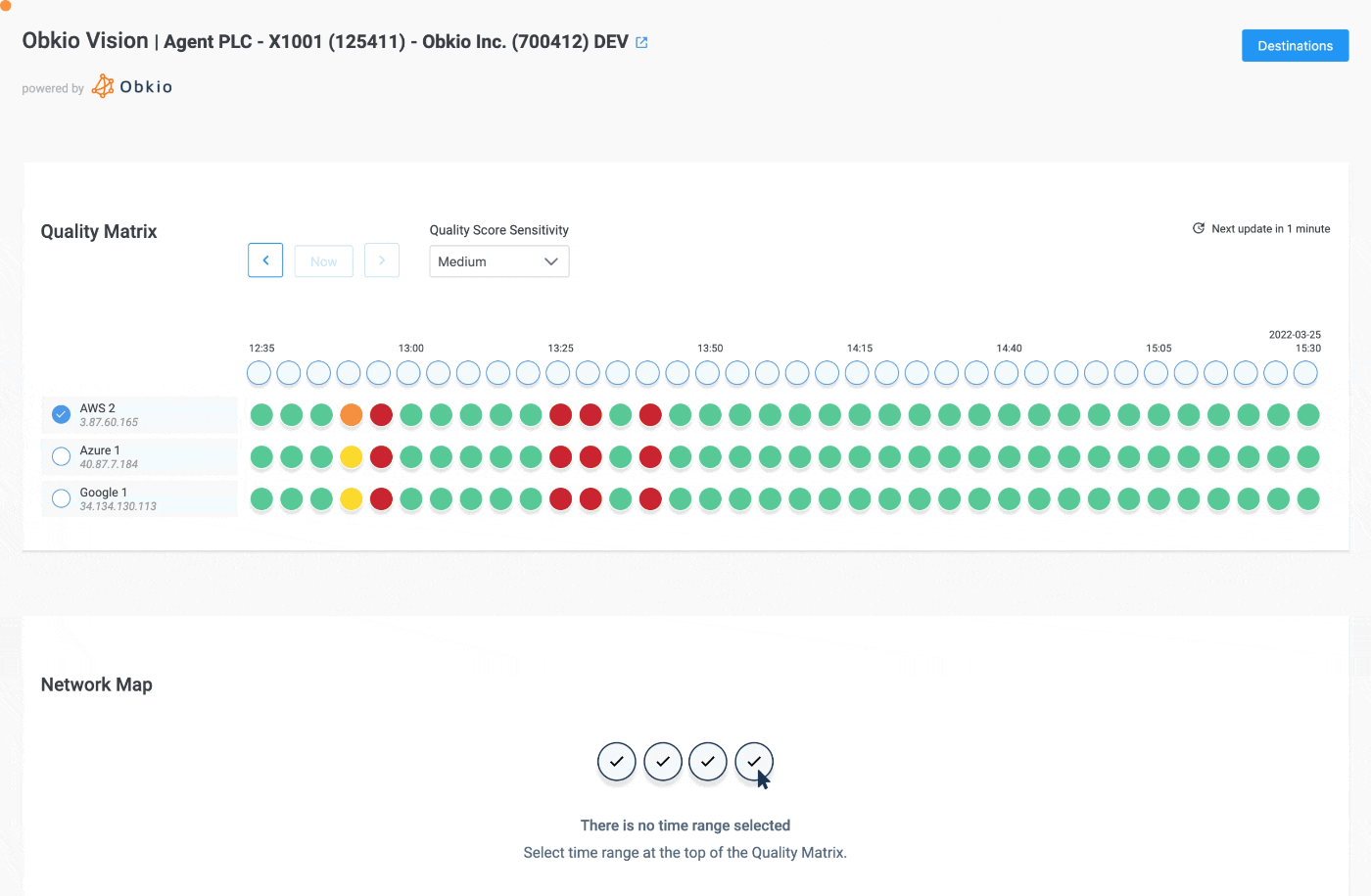

Network monitoring tools offer ongoing, real-time monitoring of network performance. They can track the behavior of data traffic, including its routing paths, and alert administrators to issues as they occur, such as when asymmetrical routing disrupts network operations.
- Historical Data: Network monitoring tools often store historical data, allowing you to track changes in routing behavior over time. This can help in identifying trends and patterns related to asymmetrical routing.
Alerts and Notifications: These tools can be configured to send alerts and notifications when specific thresholds or anomalies are detected. This proactive feature ensures that network administrators are promptly informed when asymmetrical routing issues arise.
Granular Data Analysis: Network monitoring tools provide detailed insights into network traffic and routing. This granular data analysis allows you to dive deep into the root causes of asymmetrical routing and other issues, facilitating effective troubleshooting.
In summary, when dealing with issues related to asymmetrical routing, traceroutes help with initial diagnosis, visual traceroutes provide an accessible and comparative view of routing paths, and network monitoring tools offer continuous monitoring, historical data, and alerts to ensure timely detection and response to asymmetry-related problems. Combining these tools and techniques offers a comprehensive approach to monitoring, troubleshooting, and ultimately resolving asymmetrical routing issues, leading to improved network reliability and performance.
Networks may be complex. But Obkio makes network monitoring easy. Monitor, measure, pinpoint, troubleshoot, and solve network problems.
Obkio's Network Performance Monitoring Tool is a comprehensive solution designed to empower network administrators and IT professionals with the means to gain deep insights into their network's performance, detect issues proactively, and ensure optimal connectivity.
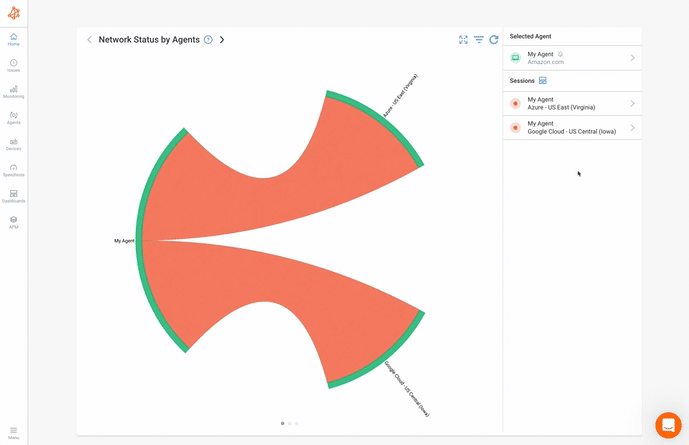
Obkio Vision is a powerful tool offered by Obkio that enhances the capabilities of traceroutes by making the data more accessible and understandable. By combining Obkio's Network Performance Monitoring Tool with Obkio Vision, network administrators gain an edge in enhancing their network monitoring and troubleshooting capabilities, especially in the context of asymmetrical routing:
- Comprehensive Network Insights: The tool and its visual traceroutes provide a comprehensive view of network performance, making it easier to identify and resolve issues, such as reverse path problems or unexpected routing paths.
- Proactive Issue Resolution: With continuous monitoring, customizable alerts, and historical data, network administrators can proactively address asymmetrical routing issues, reducing network downtime and ensuring a seamless user experience.
- Simplified Troubleshooting: The user-friendly nature of Obkio's tools simplifies the troubleshooting process, allowing administrators to quickly pinpoint the root causes of network problems.
- Optimizing Network Performance: By leveraging these tools, network administrators can optimize network performance, minimize the impact of asymmetrical routing, and ultimately ensure a reliable and efficient network.
Incorporating Obkio's Network Performance Monitoring Tool and Obkio Vision into your network management strategy equips you with the resources needed to effectively manage and troubleshoot asymmetrical routing and other network-related challenges. These tools provide the insights and capabilities necessary to keep your network running smoothly and enhance the overall quality of network service.

Reverse path issues, often referred to as "reverse path filtering" or "RPF failures," are networking problems that occur when data packets take an unexpected or incorrect path when traveling in the opposite direction of the intended route. These issues are especially prevalent in situations where asymmetric routing is involved, meaning that the forward and reverse paths for data packets do not follow the same route.
Reverse path issues can lead to various problems, including network instability, data loss, or even security vulnerabilities. These issues often result from discrepancies in the way routers and firewalls handle incoming traffic, causing packets to be dropped or misrouted if they do not follow the expected path.
- Spoofed Packets: Attackers can send spoofed packets with falsified source IP addresses. When these packets arrive at their destination, the network equipment performing reverse path filtering may incorrectly consider them invalid and drop them, even if the forward path allowed them. This can lead to legitimate traffic being blocked.
- Load Balancing and Anycast: In environments with load balancers or anycast services, incoming traffic may be balanced across multiple servers or locations. When return traffic follows a different path than the forward traffic, reverse path issues can occur. This can lead to unexpected routing and potentially impact service availability.
- Dynamic Routing Protocols: In dynamic routing environments, routes can change dynamically based on network conditions. If reverse path filtering is too rigid, it may not adapt to these changes, causing legitimate traffic to be filtered or dropped.
Reverse path issues typically occur due to the following reasons:
- Rigid Filtering Policies: Network equipment, such as routers and firewalls, may be configured with strict filtering policies that check the source IP addresses of incoming packets. If these policies are too strict and do not account for asymmetric routing, they can incorrectly classify legitimate packets as invalid.
- Dynamic Routing Changes: In dynamic routing environments, the path a packet takes can change based on network conditions. If reverse path filtering is not updated to reflect these changes, it can cause unexpected filtering or dropping of traffic.
- Inconsistent Routing Policies: Different network devices may have varying routing policies or may not share routing information accurately. When the forward and reverse paths do not align, it can result in reverse path issues.
- Lack of Visibility: In some cases, network administrators may not have sufficient visibility into the reverse path of incoming traffic, making it challenging to configure reverse path filtering accurately.
When it comes to catching reverse path issues in a network, Traceroutes are valuable diagnostic tools. Traceroutes work by mapping the path that data packets take from a source to a destination, allowing network administrators to analyze the routing of both outgoing and incoming traffic.

Here's how traceroutes can assist in detecting reverse path issues:
Path Visualization: Traceroutes provide a visual representation of the route that data packets follow as they traverse the network. By running a traceroute from a source to a destination, network administrators can see the sequence of routers and network segments the data passes through. This network visualization helps in identifying any discrepancies or unexpected routing paths.
Asymmetric Routing Detection: Traceroutes can reveal instances of asymmetric routing, where the forward and reverse paths of data packets differ. By comparing the traceroute results from the source to the destination and from the destination back to the source, administrators can pinpoint situations where the data is taking different paths, indicating a potential reverse path issue.
Identifying Filtered or Blocked Traffic: When reverse path filtering is too restrictive or not properly configured, legitimate incoming traffic may be filtered or dropped. Traceroutes can help detect these issues by showing where the traceroute path is interrupted or where the packets are dropped. If the traceroute path does not match the expected route, it suggests a problem with reverse path filtering.
Route Validation: Traceroutes can be used to validate routing changes or updates in the network. By regularly running traceroutes, administrators can ensure that both forward and reverse paths follow the desired routes and that any dynamic routing changes are accounted for.
Troubleshooting and Isolation: When network issues arise, administrators can use traceroutes to troubleshoot problems related to reverse path issues. If, for example, incoming traffic is not reaching its intended destination, a traceroute from the destination back to the source can help pinpoint where the traffic is being blocked or misrouted.
To use traceroutes effectively in detecting reverse path issues, it's important to perform traceroutes from both the source to the destination and from the destination back to the source. Comparing the results of these two traceroutes can reveal discrepancies, ensuring that both forward and reverse paths are consistent.
Additionally, regularly monitoring and analyzing traceroute data can help proactively address and prevent reverse path issues, leading to improved network performance and security.
Let’s take a look at the traceroute if there is network congestion (50% packet loss) on the reverse path between A-DAL and A-SFO exactly at the red circle on Figure D below.
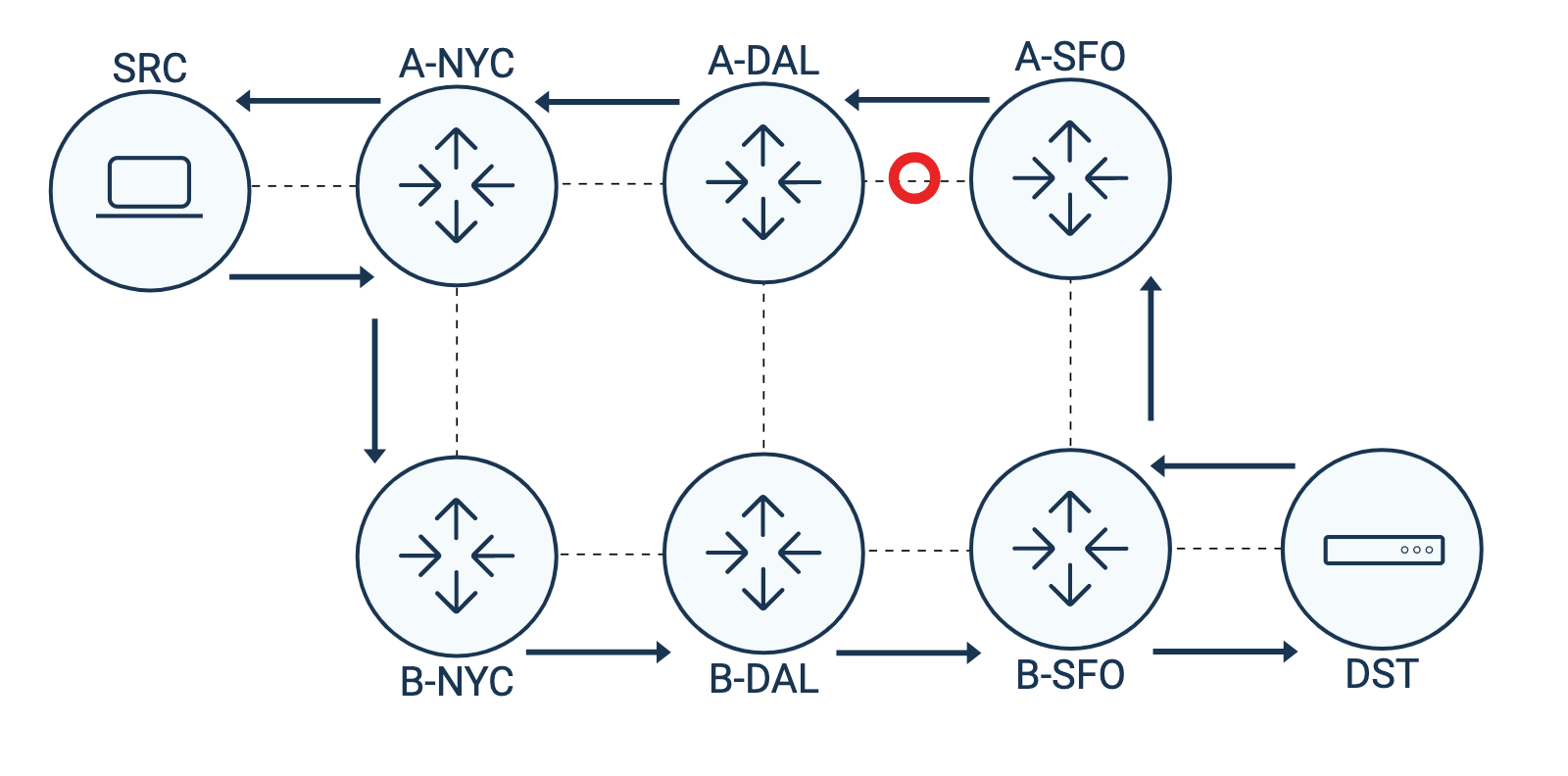
The forward path traceroute will look like Figure E.
+---+----------+-------+-----+------+------+------+------+
| # | Hostname | Loss% | Snt | Last | Avg | Best | Wrst |
+---+----------+-------+-----+------+------+------+------+
| 1 | A-NYC | 0.0 | 10 | 1.0 | 1.0 | 1.0 | 1.0 |
| 2 | B-NYC | 0.0 | 10 | 2.0 | 2.0 | 2.0 | 2.0 |
| 3 | B-DAL | 0.0 | 10 | 40.0 | 40.0 | 40.0 | 40.0 |
| 4 | B-SFO | 50.0 | 10 | 80.0 | 80.0 | 80.0 | 80.0 |
| 5 | DST | 50.0 | 10 | 81.0 | 81.0 | 81.0 | 81.0 |
+---+----------+-------+-----+------+------+------+------+
Figure E - SRC to DST during congestion
The traceroute clearly indicates a network issue because the packet loss continues below hop 4. Learn more on how to analyze a traceroute with the article How To Identify Network Issues with Traceroutes?.
If the forward and the reverse paths were the same, we could say that there is congestion inside ISP B between Dallas and San Francisco. But we know it’s not that. The congestion is in ISP A’s network. The reverse path traceroute will show us the other side of the medal:
+---+----------+-------+-----+------+------+------+------+
| # | Hostname | Loss% | Snt | Last | Avg | Best | Wrst |
+---+----------+-------+-----+------+------+------+------+
| 1 | B-SFP | 0.0 | 10 | 1.0 | 1.0 | 1.0 | 1.0 |
| 2 | A-SFO | 0.0 | 10 | 2.0 | 2.0 | 2.0 | 2.0 |
| 3 | A-DAL | 50.0 | 10 | 40.0 | 40.0 | 40.0 | 40.0 |
| 4 | A-NYC | 50.0 | 10 | 80.0 | 80.0 | 80.0 | 80.0 |
| 5 | SRC | 50.0 | 10 | 81.0 | 81.0 | 81.0 | 81.0 |
+---+----------+-------+-----+------+------+------+------+
Figure F - DST to SRC during congestion
So in that example, Figure F, the reverse traceroute from DST to SRC gave us the good answer about where the problem was, but unfortunately, there is no way for us to know which traceroute (forward or reverse) is exact. However, with that information in hand, the network engineer at ISP A and B can help troubleshoot the network issue that is affecting the traffic between SRC and DST.
To help troubleshoot the issue further, traceroutes from sources and destinations that are in the same ISP can help locate the exact issue.
Download Obkio's free Complete Guide to Traceroutes to learn to identify network problems with the most popular network troubleshooting tool for IT Pros.
Download Now

Networks are complex. There are millions of connections on the Internet where a network issue can happen. Let’s see what happens if there is 50% packet loss on the Dallas interconnection between ISP A and B.
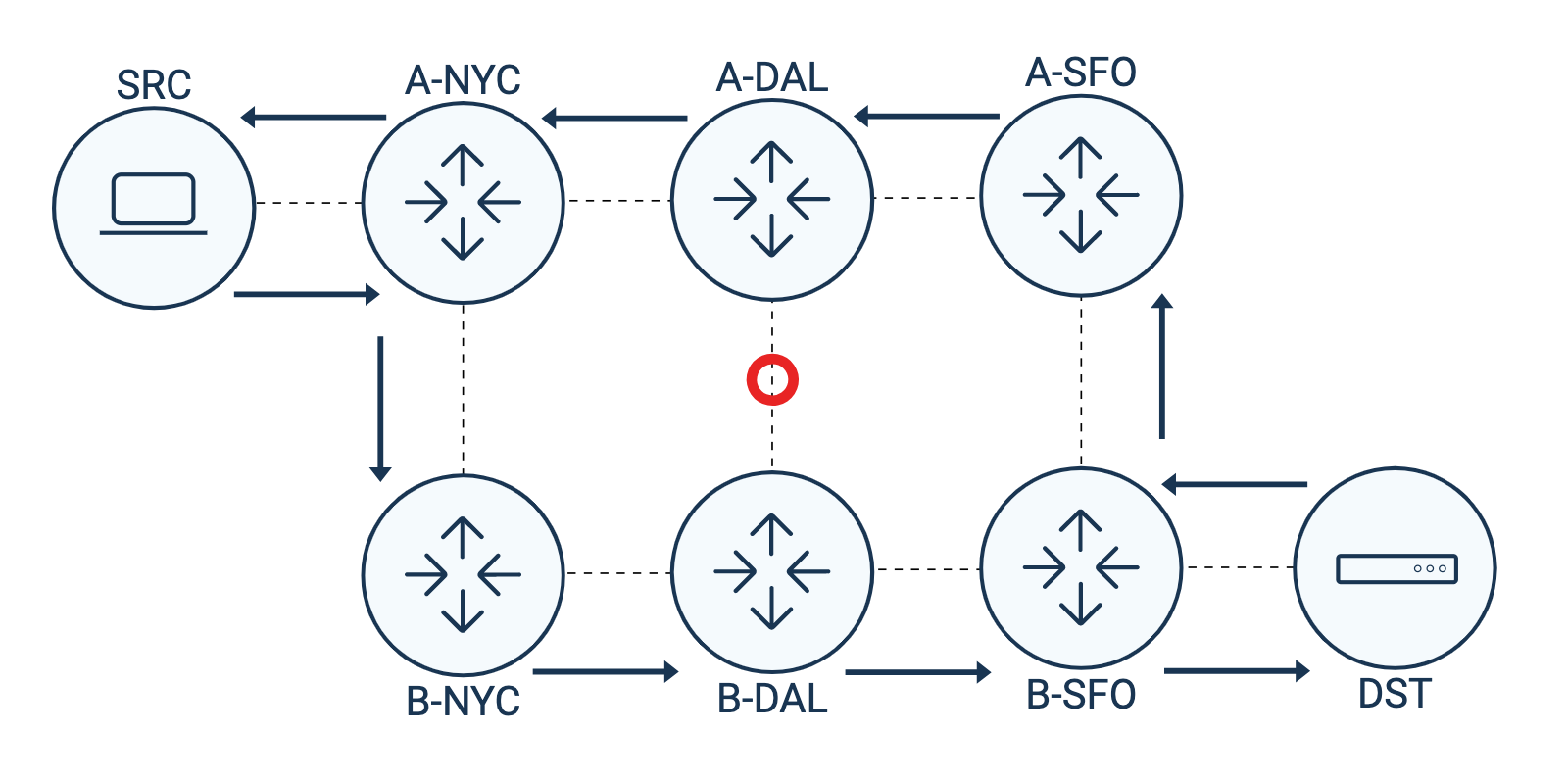
The two traceroutes look like this:
+---+----------+-------+-----+------+------+------+------+
| # | Hostname | Loss% | Snt | Last | Avg | Best | Wrst |
+---+----------+-------+-----+------+------+------+------+
| 1 | A-NYC | 0.0 | 10 | 1.0 | 1.0 | 1.0 | 1.0 |
| 2 | B-NYC | 0.0 | 10 | 2.0 | 2.0 | 2.0 | 2.0 |
| 3 | B-DAL | 50.0 | 10 | 40.0 | 40.0 | 40.0 | 40.0 |
| 4 | B-SFO | 0.0 | 10 | 80.0 | 80.0 | 80.0 | 80.0 |
| 5 | DST | 0.0 | 10 | 81.0 | 81.0 | 81.0 | 81.0 |
+---+----------+-------+-----+------+------+------+------+
Figure H - SRC to DST during congestion in Dallas
+---+----------+-------+-----+------+------+------+------+
| # | Hostname | Loss% | Snt | Last | Avg | Best | Wrst |
+---+----------+-------+-----+------+------+------+------+
| 1 | B-SFP | 0.0 | 10 | 1.0 | 1.0 | 1.0 | 1.0 |
| 2 | A-SFO | 0.0 | 10 | 2.0 | 2.0 | 2.0 | 2.0 |
| 3 | A-DAL | 50.0 | 10 | 40.0 | 40.0 | 40.0 | 40.0 |
| 4 | A-NYC | 0.0 | 10 | 80.0 | 80.0 | 80.0 | 80.0 |
| 5 | SRC | 0.0 | 10 | 81.0 | 81.0 | 81.0 | 81.0 |
+---+----------+-------+-----+------+------+------+------+
Figure I - DST to SRC during congestion In Dallas
As we learned in the article How To Identify Network Issues with Traceroutes?, if the packet loss doesn’t continue, don’t panic, there is no network issue.
Well, it's correct to assume that there is no network issue affecting the traffic from SRC to DST, but in that special case, all the ICMP TTL Exceeded responses from B-DAL to SRC are dropped at the interconnection issue because B-DAL is using the shortest path (i.e. the interconnection) to send back the packet. On the other side, the responses from A-DAL to DST are also dropped.
Here's why:
Interconnection Issue: In this scenario, an interconnection issue exists between B-DAL and SRC, causing all the ICMP TTL Exceeded responses from B-DAL to SRC to be dropped. This means that when tracing the path from SRC to DST, everything appears fine because there's no packet loss. However, the issue is lurking in the reverse path (from DST to SRC), where the responses from A-DAL to DST are also dropped due to the same interconnection problem.
Asymmetric Routing: The scenario also reveals the concept of asymmetric routing, where traffic can follow different paths in the forward and reverse directions. In this case, B-DAL uses the shortest path (the interconnection) to send the packet back to SRC, while A-DAL routes its responses differently. As a result, the responses from both B-DAL and A-DAL are being dropped due to the same issue.
This example underscores the importance of conducting a reverse traceroute, which involves tracing the path from the destination (DST) back to the source (SRC). By doing so, you can complete the picture of network routing and identify discrepancies in both directions.
Additionally, it serves as a reminder that a single traceroute may not provide a comprehensive view of network performance and issues. Network conditions can vary, and complexities like asymmetric routing, interconnections, and routing policies can lead to different outcomes for forward and reverse traceroutes.
Hence, it's crucial to exercise caution when diagnosing network problems based on a single traceroute, and always consider running both forward and reverse traceroutes to ensure a more accurate and thorough analysis of network behavior. This approach helps network administrators make more informed decisions and pinpoint the root causes of issues effectively.
As previously discussed, diagnosing network issues often necessitates an understanding of how data flows both from the source to the destination and in the reverse direction. Reverse traceroutes are a vital component of this process as they allow network administrators to analyze the complete round-trip path, which may reveal issues that are not apparent when examining only the forward path.
By running reverse traceroutes, you can identify problems like asymmetrical routing, routing discrepancies, and packet loss in both directions, providing a more comprehensive view of network performance.
Obkio's Network Performance Monitoring tool is a valuable resource for network administrators and IT professionals seeking to monitor and troubleshoot network issues. It offers the capability to perform reverse traceroutes, which is an essential feature for diagnosing network problems effectively.
By using this tool, you can obtain a clear and accurate picture of network performance, enabling you to identify and address issues that might otherwise go unnoticed.

Obkio Vision: Visual Traceroute tool, as part of Obkio's suite of tools, goes a step further in simplifying the troubleshooting process. It not only runs traceroutes in both directions (forward and reverse) but also interprets the data, making it more accessible and user-friendly.
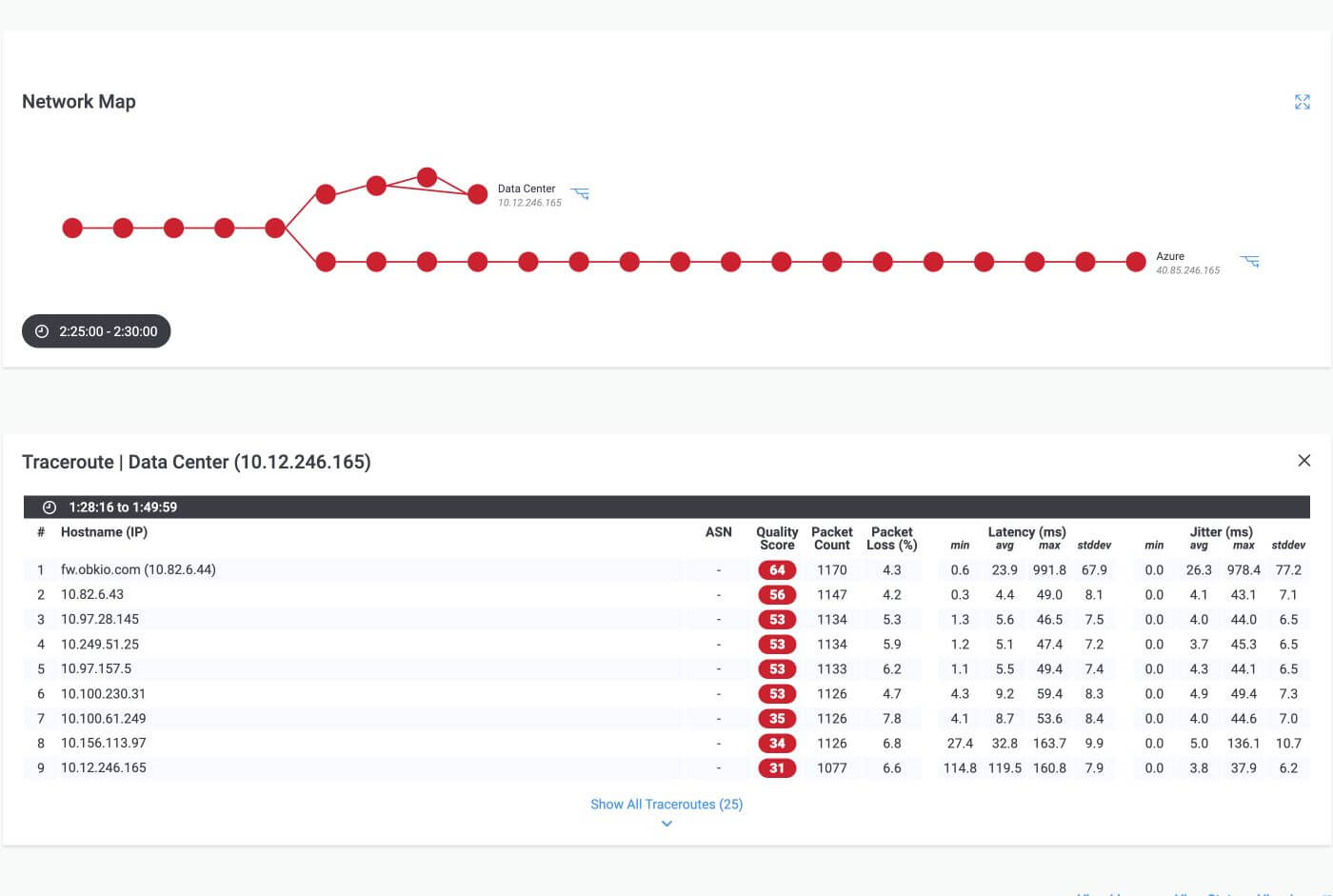
Here's how Obkio Vision can be beneficial:
Data Interpretation: Obkio Vision takes the raw traceroute data and presents it in a visually comprehensible format. It provides interactive, graphical representations of the network path, showing the sequence of routers, network segments, and their latency. This visualization aids in quickly identifying issues, even for users who may not have in-depth knowledge of networking protocols.
Historical Data Analysis: Obkio Vision often retains historical data, allowing network administrators to compare current traceroute results with past data. This can help in spotting changes or trends in network behavior, making it easier to identify persistent or recurring issues.
Alerts and Notifications: Obkio Vision can be configured to trigger alerts or notifications when network performance metrics deviate from normal values, making it easier to respond proactively to emerging issues.
By offering reverse traceroutes and streamlining the interpretation of traceroute data, Obkio's tools like Obkio Vision empower network administrators to more efficiently diagnose, troubleshoot, and resolve network issues. This ultimately contributes to enhanced network performance, reduced downtime, and improved user experiences.
Leverage Obkio Vision to monitor, detect and troubleshoot network problems with visual traceroutes, IP route historic and graphical network maps.
Try for Free

When it comes to addressing reverse path issues, a proactive and systematic troubleshooting approach can be incredibly valuable. While the specifics of troubleshooting can vary depending on the nature of the issue and the tools available, here are some essential tips and common pitfalls to keep in mind:
Consistent Forward and Reverse Traceroutes: As highlighted earlier, conducting both forward and reverse traceroutes is essential to identify asymmetrical routing issues. Make it a standard practice to run traceroutes in both directions to compare the routing paths.
Regular Monitoring: Implement continuous network monitoring to detect anomalies and asymmetrical routing issues in real-time. Set up network monitoring alerts and notifications to receive immediate notifications when problems occur.
Network Topology Review: Regularly review and update your network topology diagrams and routing configurations. This helps in visualizing and understanding the routing paths and potential discrepancies.
Historical Data Analysis: Utilize historical data from traceroutes and network monitoring to track changes in routing behavior over time. This can aid in identifying recurring issues and patterns.
Packet Captures: When faced with persistent or complex issues, consider using packet capture tools to inspect the actual network traffic. Packet captures can provide detailed insights into how packets are being routed.
Collaboration: Engage in effective communication and collaboration with other network administrators, ISPs, or peers in cases where the asymmetrical routing issue might be beyond your immediate control.
Overlooking Reverse Paths: Focusing solely on the forward path can lead to missing issues that occur in the reverse direction. Always consider both directions when troubleshooting.
Rigid Filtering Policies: Overly strict filtering policies can inadvertently block legitimate traffic. Review and adjust these policies to accommodate asymmetrical routing.
Ignoring Routing Changes: Network routing can change dynamically. Failure to adapt to these changes can result in persistent asymmetrical routing issues.
Incomplete Data: Relying on a single traceroute or incomplete data for analysis can lead to incorrect conclusions. Ensure that you have a comprehensive set of data for troubleshooting.
Lack of Documentation: Inadequate documentation of network configurations and changes can hinder the troubleshooting process. Maintain up-to-date records and network diagrams.
Not Considering Security Implications: Asymmetrical routing can have security implications. Failing to address these can lead to vulnerabilities. Review and adjust security measures as needed.
By following these troubleshooting tips and being mindful of common pitfalls, you can approach reverse path issues with a systematic and effective strategy. Troubleshooting asymmetrical routing challenges requires a combination of technical expertise, data analysis, and proactive monitoring to maintain a robust and reliable network.
So, there you have it — the fascinating world of asymmetrical routing and the tools that make it a bit less mysterious. We've explored the twists and turns of Internet traffic, the challenges it poses, and the solutions at your fingertips.
Traceroutes have proven to be our trusty sidekicks in this journey. They help us map out the paths that data takes, giving us a glimpse into the network's intricate highways. But they don't stop there; traceroutes also offer a ticket to explore the reverse route, where asymmetrical routing often plays its tricks.
Enter Obkio, our tech-savvy ally in the realm of network monitoring. Its Network Performance Monitoring Tool keeps an eagle eye on our network's vital signs, offering real-time monitoring, customizable alerts, and the wisdom of historical data. It's like having a dedicated guardian for your network, ensuring it stays in tip-top shape.

But the real gem is Obkio Vision. It's the artist of the group, turning raw traceroute data into a visual masterpiece. You can now see the routes, hops, and latencies in a way that even those less familiar with network jargon can appreciate. The best part? It covers both forward and reverse routes, revealing the full story of your network's journey.
With these tools, you're not just managing your network; you're navigating it like a pro. You can troubleshoot issues, spot irregularities, and ensure your network runs like a well-oiled machine.
So, in the fast-paced world of network management, you've got the tools and the know-how. As you put them to work, you're not just managing a network; you're embracing the future with confidence. Here's to reliable connections, robust security, and peak performance in the digital age.
Put It to the Test: Trying Is the Ultimate Way to Learn!
Networks may be complex. But Obkio makes network monitoring easy. Monitor, measure, pinpoint, troubleshoot, and solve network problems.
- 14-day free trial of all premium features
- Deploy in just 10 minutes
- Monitor performance in all key network locations
- Measure real-time network metrics
- Identify and troubleshoot live network problems

This is the end of this article on monitoring internet traffic with traceroutes. The next articles will cover how to analyze traceroutes and which information is the most important.
We hope you enjoyed this article in the traceroute series.
- What is a Traceroute and How Do Traceroutes Work?
- How To Identify Network Issues with Traceroutes?
- Why Do Some Routers Drop Packets or Have High Latencies?
- Decode the Hidden Information from Traceroute DNS
- Internet Traffic is Asymmetrical - How to Catch Reverse Path Issues? (this article)
- How to Share a Traceroute With an ISP NOC?
- Impact of Load Balancing or Multiple Paths on Traceroutes
- MPLS Networks, TTL Propagation and ICMP Tunneling


























 Obkio Blog
Obkio Blog





